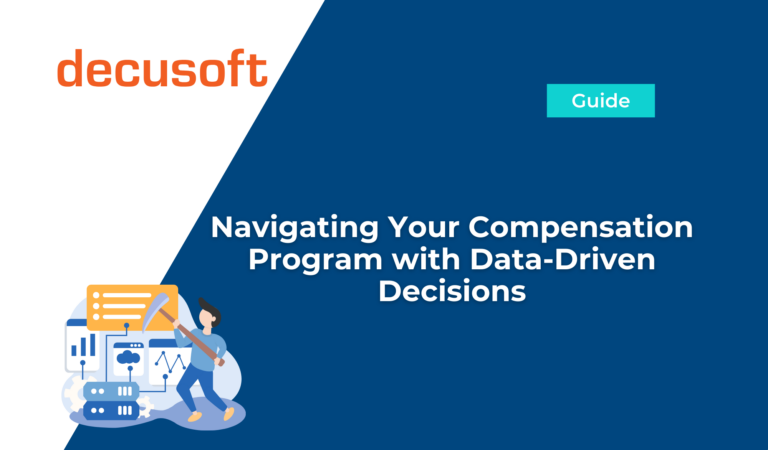The Common Challenges and Solutions With Compensation Planning
At Decusoft, we’ve been on the front lines of many comp cycles, helping businesses reengineer their compensation planning systems. This guide highlights the five biggest issues that can drag down the process and proven steps to avoid them.
If you are a human resources professional, it goes without saying that the annual or quarterly compensation cycle is going to be among your busiest times of the year. There’s a lot to be managed in a short period of time—setting budgets, checking eligibility, updating guarantees, and validating data. And there are front-line managers who need support as they review their employees.
But the comp cycle doesn’t need to be a hellish, around-the-clock pileup of administrative work to do, errors to fix, and complaints to manage. If you anticipate where the process can go awry, you can head off most of the problems and have time to work on the issues that really matter. You can even see your family and get a good night’s sleep.
1. Employee data isn’t accurate
The challenge
If you don’t have an up-to-date list of your company’s employees with their current positions and compensation, you can’t plan the next cycle. Not least, your evaluation of the total cost of a particular raise and bonus program will be off, and managers will be working from inaccurate information in their planning grids.
You would think this wouldn’t be a common problem. After all, most companies have a human resources system that manages its payroll and keeps its master employee records. In reality, though, few companies handle all of their compensation planning in their HR system.
Today, more often than not, an HR department will create spreadsheets that list each employee’s current compensation for managers to update with the appropriate bonus, raise, and other changes. These files are reviewed, consolidated, and loaded back into the HR system. There are also specialized software programs that can handle some or all of the review process.
Either way, problems occur if the information used for compensation planning gets out of sync with the underlying HR records.
How things go wrong
- Data integration issues: Manually moving information between HR systems and spreadsheets is a potential point of vulnerability. One unexpected variation in the file format can cause the transfer to go wrong. If you catch the error, you have to spend the time to fix it and redo the transfer. If you don’t see it, there will be more problems later. And if there are multiple sources of data, they need to be reconciled to avoid conflicts.
- Spreadsheet errors: Even if all information is accurate to start with, it’s easy for data to become corrupted as people work with it in spreadsheets. Users can accidentally overwrite cells or change formulas. And multiple conflicting versions can be created.
- Timing errors: Employees will continue to be hired and leave the company in the days after the data is transferred into the compensation planning system or spreadsheets. That means that managers won’t be working off the up-to-date planning grid. And it can throw the entire compensation plan off. It’s common, for example, to set a department’s bonus pool as a percentage of its overall payroll. If you aren’t counting several recent hires, everyone’s bonus will be short-changed.
How to avoid problems
- Lock key cells in spreadsheets: Avoid unintended changes in spreadsheets by locking cells that contain formulas and information from the HR system that shouldn’t change.
- Use dedicated compensation planning software: Systems with central data repositories are much less vulnerable to accidental errors. Many have built-in integrations with HR systems to minimize transmission errors.
- Create a blackout period for employee changes: Choose a date that budgets and bonus pools will be based on. Freeze compensation records as of that date for the duration of the bonus cycle.
2. Budgeting creates log jams
The Challenge
As the leadership team sets the budget for each compensation cycle and reviews the benefits and incentive plans, the HR department must provide the total cost for each option considered.
That requires calculating the prospective raise and bonus for every employee in order to estimate the total cost of a proposed compensation formula. Many HR systems and spreadsheet-based compensation systems don’t have the flexibility to support this process.
How things go wrong
- Limited calculations: The nuances of how salary ranges and bonuses are calculated are often complex and difficult to change. The formulas embedded in last year’s spreadsheet may be hard to find and understand, let alone modify. Many dedicated compensation planning software programs require custom coding to set up these calculations. As a result, management must choose between setting budgets with incomplete information or waiting as new calculations are created for each potential option.
- Rigid systems: Many HR and compensation planning systems only allow for one set of compensation formulas at a time. Evaluating multiple scenarios involves changing the entire system to calculate the cost of each option and then changing again to the selected budget.
How to avoid problems
- Choose software built for scenario planning: Some comp planning systems are designed to compare the overall cost of multiple possible compensation plans. That way, you can provide the input finance needs without having to erase and reenter your entire plan as you evaluate each scenario.
- Use technology that can create complex formulas quickly: Today, no-code technology enables HR professionals to create calculations in an easy-to-understand format without bringing in IT.
3. Managers don’t follow compensation guidelines
The Challenge
Companies ask managers to balance many factors as they recommend compensation for their employees. There’s an employee’s performance, potential, and salary progression, of course. And there are often assigned budgets and target pay guidelines for the department. Moreover, many companies ask managers to consider diversity, pay equity, and other factors.
The HR department can support managers with training, background material, and the availability of 1:1 conversations with an HR professional. But the process is most effective if the planning grids that managers fill out with their comp recommendations have the guidelines built in.
How things go wrong
- Managers don’t have the information they need to make the right recommendations: If managers don’t have ready access to each employee’s current compensation, performance ratings, and applicable guidelines, their reviews will take longer and they’ll be less likely to follow company policies.
- Planning grids don’t calculate budget allocations properly: Some HR and compensation planning software has limited ability to track how individual compensation decisions fit into the pools allocated for a team. They may not allow for departmental variations and may have a single overall budget, even when a company has separate pools for raises and bonuses. The latter forces managers to calculate totals by hand, increasing the chances of error.
How to avoid problems
- Embed employee information and comp recommendations in the planning grid: The most efficient way to support managers is for everything they need to be included in the planning grids they use for making compensation decisions. If the system generating the grid has access to all the relevant performance measures, it can propose recommended salary and bonus ranges helping managers stay within guidelines. Managers, of course, need to be able to see how the elements of the recommended comp package are calculated.
- Support complex, department-specific budgets: Ensure that managers can see the exact budgets assigned to their department in each comp category and running totals for how their recommendations correspond to the budgeted amounts.
- Alert managers when compensation violates guidelines: At a minimum, a planning grid should display a notification if a recommendation is above or below the guidelines. (In a spreadsheet, this is done using conditional formatting.) Some companies may want to prevent managers from entering an amount outside of an approved range. (This is harder to do in a spreadsheet.)
Do these challenges sound familiar?
Download our Guide to learn how a precision compensation platform can keep your planning on track.
See how your next compensation planning season could be so much better than the last one.
4. Compensation decisions are inaccurately recorded
The Challenge
Once the manager has made compensation recommendations, there are several additional steps to complete the process, each with potential pitfalls. Often the recommendations are routed first to one or more senior managers for review. Then, for companies using spreadsheets, the individual planning grids need to be merged into a new master spreadsheet.
Before completing the plan for the cycle, HR typically checks it to ensure that it is within budget, that all policies have been met, and that objectives like DEI targets have been considered. Finally, the updated compensation information for each employee is loaded back into the HR system.
How things go wrong
- Data fragmentation: With spreadsheets, there’s always a risk that someone will make a copy and open the door to confusion about which is the valid version.
- Errors: The consolidation and reintegration processes involve manual copying and formatting, making them particularly vulnerable to data errors. Moreover, a mistake anywhere in the process could cause cascading miscalculations throughout the plan. If not caught, employees could wind up getting the wrong paychecks or bonus payments.
- Policy gaps: If the cumulative plan choices aren’t tallied and analyzed, you may not have an accurate view of all the comp plan’s implications. This makes it challenging to review the plan for policy compliance, pay equity, or other factors of concern.
How to avoid problems
- Version Control: If you use spreadsheets, build procedures to ensure the most recent version is always used. Using a software system with a central data repository ensures a single source of truth and can capture an audit trail of all the actions taken by users.
- Analytics to support objectives: Decide in advance how you want to evaluate the comp plan. This might include the changes in compensation from the previous period, a comparison to benchmarks of competing companies, or a distribution of compensation by race and gender. Some comp planning software platforms include built-in analytics to show this information. Otherwise, you may need to build your own in a spreadsheet or business intelligence tool.
- Auditing: When the comp planning process doesn’t have enough guard rails and controls to prevent errors, it’s best to budget time and effort to review the calculations and recommendations in the final plan or, perhaps, to check a subset of them. Better yet, use software with a built-in audit trail.
5. Employees react poorly to compensation decisions
The Challenge
An important goal of all this effort is for your employees to feel valued, well-rewarded for the work they have done, and motivated for the future. If they don’t, top performers are likely to leave, and those who don’t will likely be disgruntled.
Many companies try to communicate the value of their comp packages by sending each employee a personalized total rewards statement. Producing these statements can be time-consuming and labor-intensive, as information from multiple systems needs to be combined and properly formatted.
How things go wrong
- Below-market compensation: If you aren’t aware of prevailing wages for each job title and geography at the company, you may miss situations where your compensation is falling behind.
- Misunderstood rewards: Employees may not appreciate the full scope of their compensation packages and how they were calculated. Many companies are daunted by the complexity of integrating information from healthcare, retirement, and other benefit systems, so they send incomplete total rewards statements or don’t use them at all.
- Expense and delay producing total rewards statements: A common method for creating total rewards statements is to use the mail merge capability of Microsoft Word or another word processor. Mail merge is time-consuming, prone to error, and difficult to customize to account for the variations in compensation and incentive schemes.
- Confidential information leaks: If employees discover details of their coworkers’ or managers’ compensation, it can lead to resentment (or worse). Companies that circulate planning grids on spreadsheets are particularly vulnerable to security breaches.
How to avoid problems
- Embed competitive benchmarks in the planning process: There are many sources of compensation levels by job type and geography. Get the most value from this data by embedding benchmarks directly in planning grids used throughout the review process.
- Produce attractive and comprehensive total rewards statements: Incorporate personal information from systems that power all of the components of your benefits packages. Customize each statement to reflect the comp structure of each employee’s department, location, union status, etc. Compensation planning software often can produce these statements more efficiently than using mail merge.
- Ensure data security: Evaluate each step of the compensation planning process for vulnerability to security breaches from inside and outside the company. If using spreadsheets, be sure to assign a distinct password to each grid and educate managers not to make insecure copies. If using human resources or compensation software, ensure that users only have access to the information that is relevant to their role.
The path to an effective compensation cycle
I’ve listed a lot of ways that compensation cycles can go off track. This isn’t meant to be depressing. I can assure you that all of the preceding issues can be prevented. In fact, simply anticipating and preparing for the potential challenges allows an organization to head off most of them.
But the choice of tools you use can also have a huge impact. As I mentioned, most companies find that the compensation module that is built into their HR system is not flexible enough for their needs. The easy choice often seems to be to copy information into spreadsheets to handle the compensation plan. But spreadsheets are often the root cause of many of the problems that come up.
Dedicated compensation planning software offers significant advantages. It keeps data centrally, avoiding fragmentation and enabling better security. It can connect to your HR and payroll systems seamlessly to streamline workflows, And it has a range of features meant to handle the common, and often complex, tasks of the planning process.
Discover the power of Compose
Compose, the compensation planning platform from Decusoft, offers the flexibility to handle any compensation cycle with ease. It has the unmatched capability to incorporate any bonus or incentive structure, no matter how complex, with unlimited variations of planning grids. Calculations can be created and changed by nonprogrammers using its no-code technology. And it has powerful, customizable capabilities for data integration, analytics, auditing, reporting, and more.
Get a demo today by clicking here.




